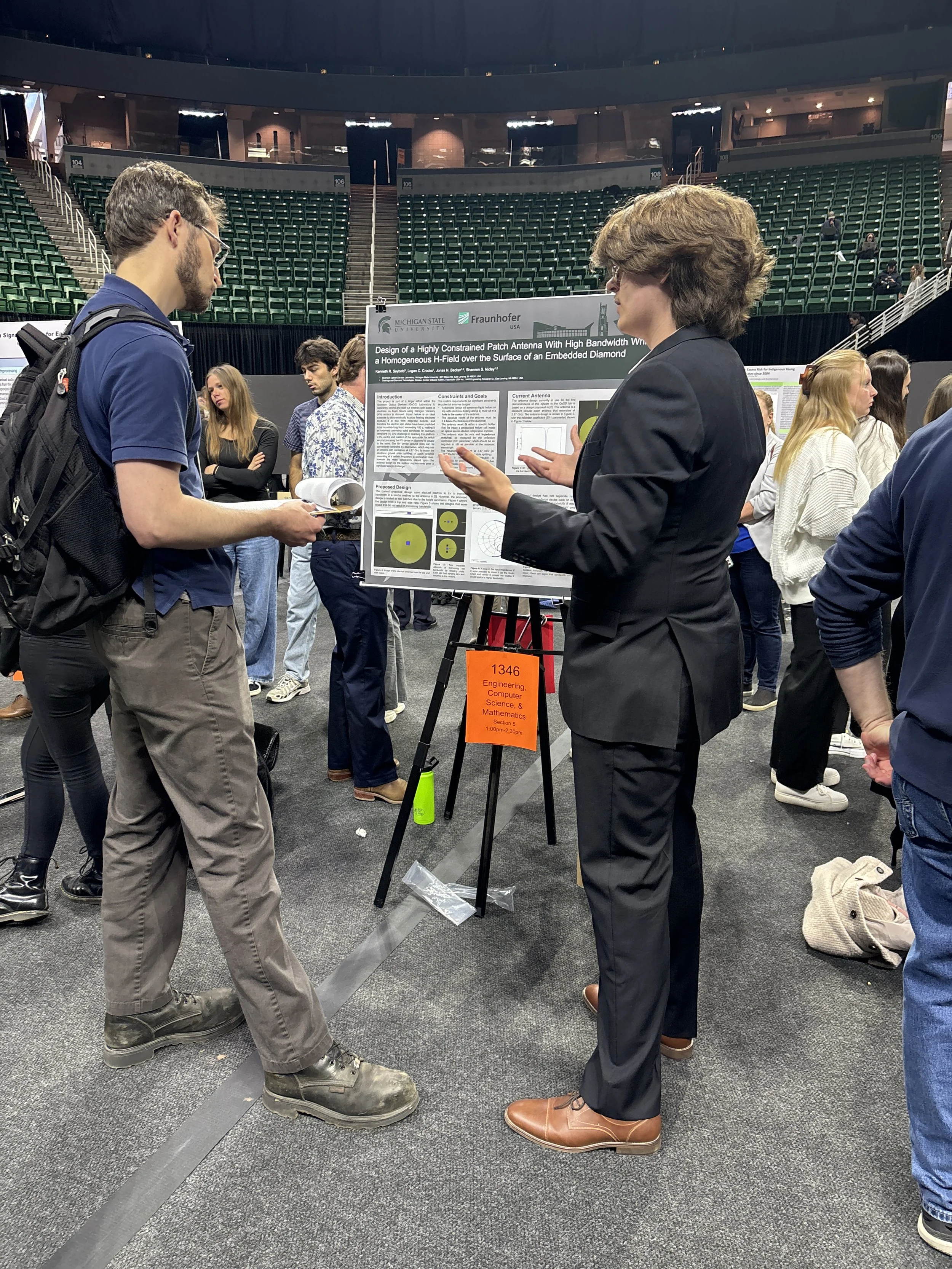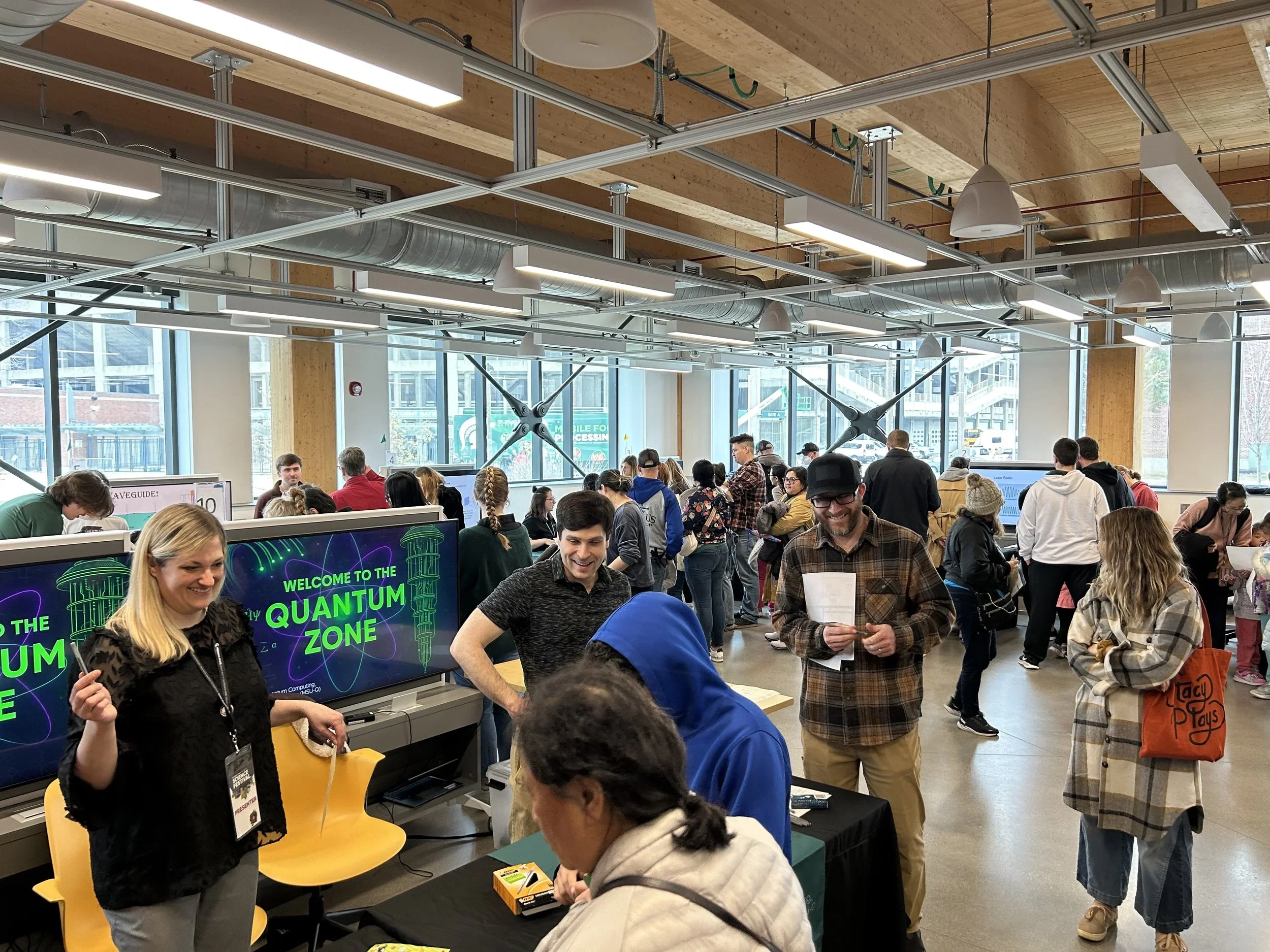Quantum Optical Devices Laboratory
Professorial Assistantship
As a Professorial Assistant, I was assigned to Quantum Optical Devices Laboratory (QUoD) as the laboratory I would work with. Specifically, I was assigned to Shannon Nicley as my faculty advisor. From there, I was assigned to work on a RF design project. This project aimed to increase bandwidth on a patch antenna for stronger electron control (if this interests you, you can read the paper this project is based on [link]). As a freshman, it was a daunting task as RF design was taught to mostly seniors or graduates.
The first semester was dedicated to learning exactly how RF design works and how to utilize AWR Microwave Office (MWO). Learning MWO was a challenge but a challenge that I was able to overcome. From then, I started simulating at which point I learned the difference between 2.5D solvers and full 3D solvers. This one revelation forced me to switch to a 3D solver which allowed me to get more precise results. Over the next semester, I started simulating using the 3D solver and found results that increased the bandwidth from 20MHz to 70MHz. I then compiled and presented these results at UURAF, an undergraduate research symposium. At UURAF I talked to several judges where I explained how my designs would be able to increase the efficiency of QUoD’s current antenna. After UURAF, I was notified that I had won an engineering section award out of 40 other participants.
During the time I was preparing for UURAF, I was also organizing the MSU Quantum Lab’s part in MSU SciFest. This effort saw me organize around 20 volunteers to host the Quantum Zone. The Quantum Zone hosted thousands of local residents over the weekend SciFest was ran. The few weeks I was organizing my UURAF presentation and organizing for SciFest was a logistical nightmare where I felt like my head was on fire. However, to be able to say I gave an award winning presentation and organize a large event within the same week is something I look back on with pride.
My current work at QUoD is an extension of last years work, however, I have switched to using Ansys HFSS for better 3D simulation.
The current antenna drawn in Ansys HFSS
Pictures of me giving my UURAF presentation and winning my section award
The Quantum Zone at MSU SciFest
MSU Solar Racing Team
Solar Energy System
I joined MSU Solar Racing Team in August of 2024. As a new recruit, I joined the Solar Energy Systems Team which was and still is led by Hector Beltran. As a member of this team, I was expected to learn how to solder solar panels, validate the panels, laminate the panels, and install bypass diodes. Over the first year, I created small solar panel segments to repair broken panels within the larger panels. Through doing this, I had to solder them and test the panels with a multi-meter.
The other project I was working on was helping to wire bypass diodes to improve the power output of our panel system. This involved a decent amount of planning on the part of where diodes would be placed, wired, and connected. In the end, time ran out so the project was scrapped in order to have Cynisca (our 2025 car) ready for competition.
As of right now, I am the second in command for the Solar Energy Systems Team. As an entire team, we are working to design and manufacture a car within the year for the 2026 season. As such, several big design aspects of our team was changed. We landed on using a modular design for the panels to improve the ease of fixing the panels, and employing a PCB to hold the bypass diodes. I am currently the project lead for the design of the PCB for the bypass diodes. This project employs a STM32 MCU that can read if a bypass diode is active and send that data across a LIN. By doing this, it allows us to instantly tell if a solar panel is faulty which will improve the time it takes to repair our panels and ensure we have the highest possible power output to our battery.
I also spend some of my time as a member of the Battery Protection System. At the start of the 2025 year, the lead approached me and asked for me to join the team for this year as they are leaving next fall so they wanted me to be able to take the leadership role. This team acts as the start up system for the car and has one central PCB that uses a STM32 MCU which monitors the high voltage system in our battery before fully starting the car. As of right now, I have designed a simple 24V-3V3 and 24V-5V buck converter for our lower power boards.
FRC Team 2767 StrykeForce
Programming Team Member
I joined StrykeForce in my sophomore year of high school as a member of the Programming Subteam. During the first year, I learned Java and WPILib which is the library that we used. It really isn’t until the second year where I started to thrive. In my second year, I started to focus on 3D localization with vision systems. As an extension, I learned a lot about automation and computer vision. Furthermore, in both my first and second years, I was getting hands on experience with control systems, handling programming in a team project, and learning how to engineer. However, in my senior year, things changed.
In my senior year, I was made the Programming Team Lead. As Lead, I led several projects and played a large role in changing how we structure our programming team. One of the first things I changed was our vision system, as I had used it extensively, I did not like using it and believed that it would be best to develop our own custom system. This development was quite lengthy and took an entire off season to get a version that was good enough to go to competition. I and one other student worked on this project. I focused on the computer vision, data processing, and networking with the other student focused on the web interface, Linux integration, and general loop structure. Through doing this, we were able to come up with a fully in-house software that would be able to be updated whenever the team needs a custom feature. Furthermore, we were able to customize how the data is processed and improve our accuracy.
One other major project I worked on was a upheaval of how we handled our automation. In years past, for every autonomous routine, we would spin up a custom command for every single routine. This was usually a lengthy and somewhat involved project. When the year’s game required many routines, it meant that we would spend a significant amount of development time purely on writing routines. In my senior year, the game could feasibly have hundreds of unique routines. As such, a change was needed. This is where I came up with the idea of creating an autonomous handler which would be able to take minimal input and produce a routine that was as effective as our old system. This resulted in our routine development time taking hours to only taking minutes. There were even times in competition where we created a unique routine on the fly without testing it.
The last major project I will talk about is our how we tracked game pieces. Due to the game pieces being bright orange, we theorized that we could detect the pieces by looking for that specific color. As such, I went to work working with a vision software that would filter the image for the color and use two PID loops to control our robot to drive and pick up the piece. This system was integrated into all of our autonomous routines so we would use full 3D localization for 90% of the routine but when we needed to pick up pieces we would switch to using the data our camera would feed us to get us the rest of the way. It was so effective that we went from being 60% accurate to almost 100%. The drivers liked it enough to also implement it when they couldn’t see so all they had to do was push a button and the robot would automatically pick the piece up.
In all, my time on 2767 taught me very valuable things not only about myself but also how to handle team environments. I would not be the student, the person, or the engineer without these experiences. It gave me confidence in my ideas and also showed me that as long as I am in the right environment I could not only succeed but thrive.
KAMSC Sizzlin’ Summer
Teacher / Teacher Assistant
Over the summers of my high school years and freshmen year of college, I worked at KAMSC Sizzlin’ Summer which is a STEM summer camp. I worked as a Teacher Assistant and as a Teacher. The camp had kids ranging from 6-16 and could have classrooms of 5-20 kids. The camp was structured by having three 2.5 hour classes for the entire day. These classes could be simple physics, math, model rockets, game coding, or a variety of other topics.
As a TA, it is pretty simple, you get delegated tasks to make sure the class would run smoothly and take as much pressure off the teacher as possible. Now being a teacher is a completely different ball game. As a teacher, you have to come up with a somewhat comprehensive lesson plan and learn how to stick to it. You would also have to manage a class of up to 20 rambunctious kids. This is a lot to ask however, it is manageable. I personally loved this position as I love teaching and inspiring people which was one of the main responsibilities for the teachers. I also learned Unity through this job as a co-worker developed an entirely new class where he taught Unity to high schoolers and saw me as a heir to the class. After he left, I taught the class twice and was able to get kids to develop a fully functional game in Unity in two weeks (THIS IS NOT EASY, if you think it is try it yourself). My time here showed me how to manage people, lead rooms, and showed that I love teaching.
Other Various Experiences
ECE 202 Help Room Tutor
(Sept 2025 - present)
ECE 202 is MSU’s ECE class that deals with AC analysis.
Class content includes: Phasor analysis, S-Domain analysis, Bode plots, frequency filters, etc
I run the Help Room where students may come looking for help and I work with them to teach the content to them.
ECE Undergraduate Studies Committee
(Sept 2025 - present)
I am currently sitting on the ECE Undergraduate Studies Committee as an Undergraduate Committee Member
I aim to help the committee refine MSU’s ECE Undergrad classes as a current Undergrad



